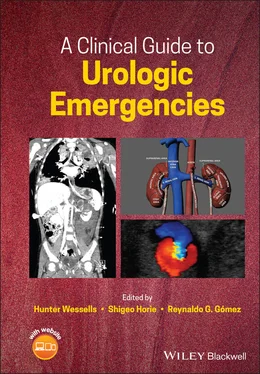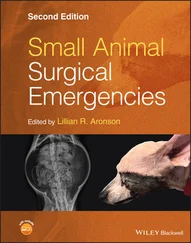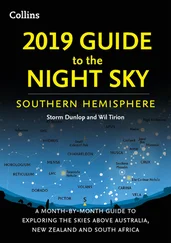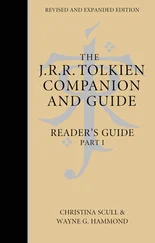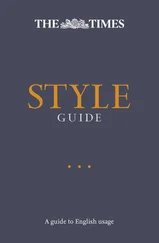A Clinical Guide to Urologic Emergencies
Здесь есть возможность читать онлайн «A Clinical Guide to Urologic Emergencies» — ознакомительный отрывок электронной книги совершенно бесплатно, а после прочтения отрывка купить полную версию. В некоторых случаях можно слушать аудио, скачать через торрент в формате fb2 и присутствует краткое содержание. Жанр: unrecognised, на английском языке. Описание произведения, (предисловие) а так же отзывы посетителей доступны на портале библиотеки ЛибКат.
- Название:A Clinical Guide to Urologic Emergencies
- Автор:
- Жанр:
- Год:неизвестен
- ISBN:нет данных
- Рейтинг книги:5 / 5. Голосов: 1
-
Избранное:Добавить в избранное
- Отзывы:
-
Ваша оценка:
- 100
- 1
- 2
- 3
- 4
- 5
A Clinical Guide to Urologic Emergencies: краткое содержание, описание и аннотация
Предлагаем к чтению аннотацию, описание, краткое содержание или предисловие (зависит от того, что написал сам автор книги «A Clinical Guide to Urologic Emergencies»). Если вы не нашли необходимую информацию о книге — напишите в комментариях, мы постараемся отыскать её.
A Clinical Guide to Urologic Emergencies
www.wiley.com/go/wessells/urologic A Clinical Guide to Urologic Emergencies
A Clinical Guide to Urologic Emergencies
A Clinical Guide to Urologic Emergencies — читать онлайн ознакомительный отрывок
Ниже представлен текст книги, разбитый по страницам. Система сохранения места последней прочитанной страницы, позволяет с удобством читать онлайн бесплатно книгу «A Clinical Guide to Urologic Emergencies», без необходимости каждый раз заново искать на чём Вы остановились. Поставьте закладку, и сможете в любой момент перейти на страницу, на которой закончили чтение.
Интервал:
Закладка:
Table of Contents
1 Cover
2 Title Page A Clinical Guide to Urologic Emergencies Edited by Hunter Wessells, MD, FACS Professor and Nelson Chair of Urology Department of Urology University of Washington School of Medicine Seattle, WA, USA Shigeo Horie, MD, PhD Professor and Chairman Department of Urology Juntendo University Graduate School of Medicine Tokyo, Japan Reynaldo G. Gómez, MD, FACS Chief of Urology Hospital del Trabajador Santiago, Chile
3 Copyright Page
4 Dedication Page
5 List of Contributors
6 PrefaceA Clinical Guide to Urologic Emergencies References
7 List of Abbreviations
8 About the Companion Website
9 Section I: Upper Urinary Tract 1 Blunt Renal Injuries Epidemiology, Etiology, Pathophysiology Diagnosis Management Complications and Follow‐Up Conclusions References 2 Penetrating Renal Trauma Introduction Anatomy Evaluation Management Conclusion References 3 Renal Infections Introduction Acute Pyelonephritis Emphysematous Pyelonephritis Xanthogranulomatous Pyelonephritis Chronic Pyelonephritis Renal Abscess Conclusions References 4 Acute Kidney Stone Management Introduction History and Physical Management of Symptoms Medical Dissolution Therapy Acute Procedural Intervention Prognosis Special Considerations Conclusion References 5 Traumatic Adrenal Hemorrhage Introduction Relevant Anatomy Etiology Staging Presentation Imaging Management Complications of Adrenal Trauma Conclusion References 6 External Ureteral Trauma Introduction Anatomical Considerations Mechanisms of Injury Concomitant Injuries Diagnosis Management Complications Conclusions References 7 Iatrogenic Ureteral Injury Introduction Etiology Management Timing of Repair Surgical Technique Outcomes and Complications Conclusions References
10 Section II: Lower Urinary Tract 8 Bladder Injuries Introduction Long‐term Consequences Complications Conclusion References 9 Traumatic Urethral Injuries Introduction Initial Management of Suspected Trauma to the Lower Urinary Tract Urethral Trauma Management in the Acute Phase Delayed Management Conclusions References 10 Acute Management of Urethral Stricture Introduction Etiology of Urethral Stricture Patient History and Physical Examination Evaluation of Urethral Stricture Emergency Management of Urinary Retention and Unexpected Urethral Stricture Elective Management of Urethral Stricture Post‐operative Follow‐Up Conclusion References 11 Prostatitis and Prostatic Abscess Introduction Classification Presentation Management Diagnostic Imaging Prostatic Abscess Conclusions References
11 Section III: External Genitalia 12 Fournier's Gangrene Introduction Epidemiology Etiology Bacteriology Clinical Symptoms and Imaging Treatment Conclusions References 13 Traumatic Penile Injuries Introduction Pathophysiology of Traumatic Penile Injury Conclusions References 14 Priapism Introduction Epidemiology Pathophysiology and Causes Evaluation and Diagnostic Workup Treatment Effects of Priapism on Erectile Function Summary References 15 Traumatic Scrotal and Testicular Injuries Introduction General Evaluation Imaging Management Combat‐Related Scrotal Injuries Considerations Conclusions References 16 Testicular Torsion Introduction Epidemiology Pathophysiology Presentation Diagnostic Evaluation Management Outcomes Conclusions and Future Directions References 17 Epididymitis and Orchitis Introduction Anatomy and Physiology Epidemiology Pathophysiology Infectious Epididymitis Non‐infectious Epididymitis Chronic Epididymitis Diagnosis Treatment Complications Conclusion References
12 Section IV: Pediatric 18 Urologic Neonatal Emergencies Introduction Posterior Urethral Valves (PUV) Epispadias, Bladder and Cloacal Exstrophy Neonatal Testicular Torsion Disorders of Sex Development Female Genital Masses Conclusions References
13 Section V: COVID‐19 19 Urologic Emergency Care in the COVID‐19 Pandemic Era Immediate Responses of Urology Departments Surgical Triage Telemedicine Consequences of COVID‐19 on Urologic Care Conclusions References
14 Index
15 End User License Agreement
List of Tables
1 Chapter 1 Table 1.1 Demographics of renal trauma. Table 1.2 2018 American Association for the Surgery of Trauma (AAST) organ in... Table 1.3 Long‐term follow‐up recommendations.
2 Chapter 2 Table 2.1 AAST Renal injury classification, revised in 2018.
3 Chapter 3 Table 3.1 Factors associated with complicated UTI (pyelonephritis). Table 3.2 Pathogens associated with complicated and uncomplicated UTI. Table 3.3 Pathogens causing acute pyelonephritis [2]. Table 3.4 CT findings in acute pyelonephritis.Table 3.5 Classification of emphysematous pyelonephritis.Table 3.6 Factors associated with mortality in emphysematous pyelonephritis.Table 3.7 Staging of Xanthogranulomatous pyelonephritis [56, 67].
4 Chapter 4Table 4.1 Differential diagnosis of renal colic.Table 4.2 Comparison of imaging modalities for renal colic.Table 4.3 Indications for urgent decompression, via ureteral stenting or plac...Table 4.4 Estimated spontaneous passage rate and time‐to‐passage, by stone wi...
5 Chapter 5Table 5.1 The American Association for the Surgery of Trauma (AAST) organ inj...
6 Chapter 6Table 6.1 AAST organ injury scale: ureter.Table 6.2 Ureteral trauma: patterns and mechanism of injury.
7 Chapter 7Table 7.1 Outcomes of ureteral reconstruction for injury a
8 Chapter 9Table 9.1 Classification of urethral injuries.Table 9.2 Mechanisms of anterior urethra injury.
9 Chapter 11Table 11.1 Empirical antibiotic choices for acute prostatitis.
10 Chapter 12Table 12.1 Fournier's Gangrene Severity Index (FGSI).
11 Chapter 13Table 13.1 American Association for the Surgery of Trauma (AAST Penis Injury ...
12 Chapter 14Table 14.1 Blood gas findings in priapism.Table 14.2 Etiology of ischemic priapism.Table 14.3 Clinical findings in priapism.Table 14.4 Treatment options for stuttering priapism.
13 Chapter 15Table 15.1 AAST scrotal injury scale [16].Table 15.2 AAST testicular injury scale [16].
14 Chapter 16Table 16.1 Differential diagnosis of the acute scrotum.Table 16.2 European Association of Urology summary of evidence and recommenda...Table 16.3 Relationship between time, testis salvage, and testis atrophy. a
15 Chapter 18Table 18.1 Predictive amniotic fluid variables.
16 Chapter 19Table 19.1 Urgent and emergent urological patients, mean (standard deviation)...
List of Illustrations
1 Chapter 1 Figure 1.1 American Association for the Surgery of Trauma (AAST) Organ Injur... Figure 1.2 CT images of renal injuries including: (a) axial view of a left s... Figure 1.3 Nomogram predicting bleeding interventions after high‐grade renal... Figure 1.4 Surgical approach to renal vessels and hilum. (a) Relationship be... Figure 1.5 Surgical management of vascular injuries. (a) Schematic showing i...
2 Chapter 2 Figure 2.1 The kidneys and their association with adjacent organs. Figure 2.2 Proposed Proposed treatment algorithm. CT, computed tomography; H... Figure 2.3 Twenty‐one‐year‐old male who sustained a GSW to the abdomen. He h... Figure 2.4 Twenty‐five‐year‐old female who sustained multiple stab wounds wi... Figure 2.5 Renorrhaphy. (a) Deep midrenal laceration into pelvis. Basic reco... Figure 2.6 Forty‐four‐year‐old male who sustained a GSW with a grade III lef...
3 Chapter 3 Figure 3.1 Striated nephrogram in right kidney in acute pyelonephritis.Figure 3.2 Emphysematous pyelonephritis of right kidney.Figure 3.3 Emphysematous pyelonephritis with nephrostomy tube in situ .Figure 3.4 Xanthogranulomatous pyelonephritis.Figure 3.5 Left renal abscess (arrowhead).
4 Chapter 4Figure 4.1 Suggested algorithm for diagnostic imaging for acute renal colic....Figure 4.2 CT KUB demonstrating two ureteral stones (arrows) within the left...Figure 4.3 Renal ultrasound shows a proximal ureteral stone (yellow cross ma...Figure 4.4 Plain film abdominal x‐ray demonstrates a large radiopaque left p...Figure 4.5 Plain film abdominal x‐ray demonstrates a right ureteral stent in...
Читать дальшеИнтервал:
Закладка:
Похожие книги на «A Clinical Guide to Urologic Emergencies»
Представляем Вашему вниманию похожие книги на «A Clinical Guide to Urologic Emergencies» списком для выбора. Мы отобрали схожую по названию и смыслу литературу в надежде предоставить читателям больше вариантов отыскать новые, интересные, ещё непрочитанные произведения.
Обсуждение, отзывы о книге «A Clinical Guide to Urologic Emergencies» и просто собственные мнения читателей. Оставьте ваши комментарии, напишите, что Вы думаете о произведении, его смысле или главных героях. Укажите что конкретно понравилось, а что нет, и почему Вы так считаете.
